Beautiful Beadboard Paneling That’s Surprisingly Easy

Adding beautiful architectural interest to your home not only adds value, but also makes your home yours. Clearly, there are many ways you can add details to your home that create character. I’ve always been drawn to styles and looks that create a sense of history, that make it feel like it’s been around for decades. Personally, I believe adding traditional beadboard paneling not only adds cottage charm to any room, but also creates a sense of history.
We have updated every space in our home except the laundry room, so this is the year! The space of the laundry room is not bad, but the finishes never reflected me or my tastes. From the florescent light fixture to the laminate and oak cabinets, it all needs to go.
My plan it not only to update the laundry room, but also create an area for jackets, coats and shoes. Actually, creating a mini mudroom within the laundry room.
You know, I’ve been a little envious ever since we built Steph’s mudroom.
Not to mention when Alex and Megan built their mudroom bench.
For phase one of this makeover, we will begin with the long wall to the right when you enter the laundry room. I feel like this is the perfect space to create hanging storage.
My first thought was to create a board and batten wall. But I feel like that’s not really the style of my home.
So, as I thought about it a bit more, I thought a traditional beadboard paneling would be more fitting for my home.
Adding a traditional beadboard paneled wall is really not that difficult. In fact, Steph and I were able to complete it in an afternoon. Scroll down and see our time saving tips.
Hometalk Recommends!
You’ll find a list of materials and tools we used below.
Materials:
- 4’x8′ Beadboard panel
- 1″x6″ primed pine board
- 1/2″ x 1 1/2″ primed MDF board
- Nail hole filler
- Caulk
Tools:
- Table saw
- Chop saw
- Oscillating tool
- Pneumatic brad nailer
- Caulk gun
- Putty knife
- Level
(This post contains affiliate links for your convenience. As an Amazon affiliate we earn from qualifying purchases. See our disclosure for details.)
There are a few steps to do to prepare your wall for beadboard paneling.
- First, we removed the adjacent door casing and base board.
- Second, we made a level line for the height of the beadboard paneling. Our paneling will be a 5′ high wainscoting. By doing this I will be able to create hooks for hanging storage.
- Third, using a stud finder, we marked where the studs were located in the walls.
Pro-Tip: to make the installation easier. We had each beadboard panel cut at The Home Depot to the height we needed, 5 feet.
As with any paneling, you will want to attach not only with brads or nails at the studs, but also you will want to add construction adhesive.
This step is really important on the edges of the beadboard. When installing each panel you may or may not have a stud to nail into at the edge of the panel.
Therefore, it’s important to make sure you run a solid bead of construction adhesive along each side. Just to make sure that it is secured well to the wall, we added a bit of adhesive along the top and bottom and randomly along the rest of the panel.
Next, we placed the panel along our level line and secured it with brads at each stud.
As you install your beadboard paneling, you will certainly come to outlets, or switches that will require you to make cuts.
We did have one outlet on the wall that we needed to make a cut for. I’ll be totally honest, this part made me a little nervous. As it turned out it was a lot easier than I thought.
First, we measured the distance of the outlet from the top and side of the beadboard panel. Then we marked the backside of the beadboard panel.
All my anxiety over cutting this out was unnecessary. We used a wood blade in the oscillating tool and it cut through like butter. It worked like a charm.
If you do not have access to an oscillating tool you could also drill a pilot hole and use a scroll saw to get the job done too.
With our beadboard panel only covering a portion of the wall, the top edge will need some sort of edge to make it look finished.
Because I will be adding hooks for jackets and coats I wanted a substantial piece of wood to finish off the beadboard.
For this piece of wood I chose a 1″x6″ primed pine board. It was clear, with no knot holes.
We secured it to the wall at each stud with 2 nails.
The length of the wall was too long for just one board.
Therefore to create a seamless joint, we cut a 45° angle on each board. Then when installing the boards will fit tightly together.
Finally, to finish off the header we attached a 1/2″ x 1 1/2″ primed MFD board.
In addition, to finish off the lower edge of the beadboard panel we install new baseboards.
In fact, this was the final room to get the new baseboards that we had installed throughout our home.
We are now nearing the home stretch. To make everything look finished and neat, it’s time to caulk and putty.
Because these beadboard panels are not tongue and groove, there is a slight gap where each panel meets.
This is easy to conceal by running a bead of caulk at each seam.
Steph is a pro at this and I always leave this job for her.
A bead of caulk was also run at the top of the header and on the top edge of the baseboard.
To conceal all of the nails we applied Drydex nail hole filler. Then when it’s dry, you give it a light sanding with a foam sanding block until smooth.
Pro-Tip: Purchasing primed boards will save you time.
If your boards are not primed, you will want to prime them first. All of our boards were primed except for the baseboard.
Because of the groove of the beadboard, I decided to use our Wagner paint sprayer.
I did one coat horizontally and one coat vertically using the detail nozzle.
While I love this nozzle to get a beautiful smooth finish on furniture, it does not work as well on large areas like a wall. Once the paint had dried the beadboard panel looked blotchy.
I really wanted to create a smooth finish on the beadboard without brush marks. However, I finally used a small foam roller and rolled a 3rd coat and got just the finish I wanted.
Personally, I love this wall! It totally changes the feel of my laundry room. Now, if I were to turn the camera the opposite direction, it would look the same, but the right side of my room looks amazing.
Here’s a sneak peak of next week’s post. Be sure to check out this beautiful wallpaper accent wall.
Not only is this wall beautiful now, but it’s also functional. When we come in through the garage, we now have a place to hang our coats, jackets and bags. Yeah!!!
I can’t wait until the shoe storage is in place too.
What do you think of my mudroom addition to my laundry room?
Do you love the beadboard accent wall?
Is this a project you would like to try?
We’d love to hear your thoughts on this project.
Please PIN and share with your friends! Sharing is caring! If you’re new here, WELCOME! We love to meet new friends.
Say hi in the comments below, we’d love to hear from you. You can also learn more about us here.
Thanks for spending some time with us today!
And as always here at Sunny Side Design
WE HOPE TO BRING YOUR HOME TO THE SUNNY SIDE OF THE STREET!
Be sure to follow us on Pinterest for even more home decor and DIY ideas.
To see what we are working on before it’s on our blog, follow us on Instagram.
You can also find our video tutorials on our YouTube channel.
Enjoyed the project?
Resources for this project:
See all materials
Comments
Join the conversation
-
 Sharon L Rabideau
on May 07, 2022
Sharon L Rabideau
on May 07, 2022
that is just beautiful!!
-
 Sunny Side Design
on May 07, 2022
Sunny Side Design
on May 07, 2022
Thank you so much
-
-
-
 Lyle McElwee
on May 07, 2022
Lyle McElwee
on May 07, 2022
awesome job,,looks beautiful,,,thanks for sharing..
-
 Sunny Side Design
on May 07, 2022
Sunny Side Design
on May 07, 2022
Thank you Lyle.
-
-
-



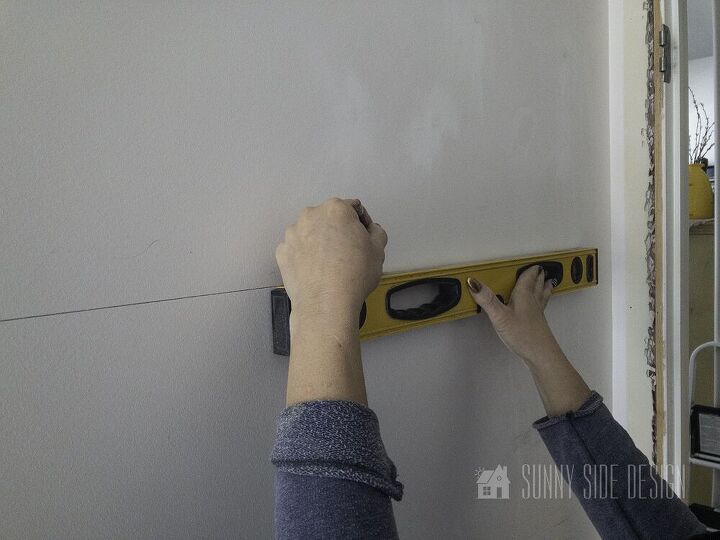

























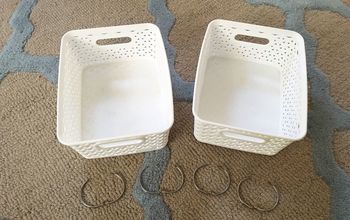
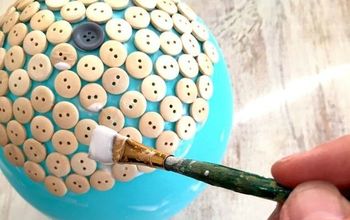



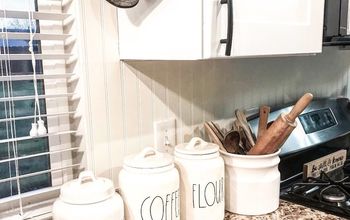
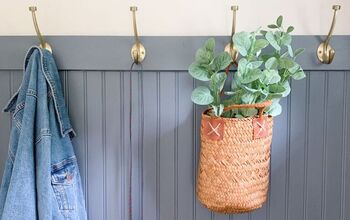
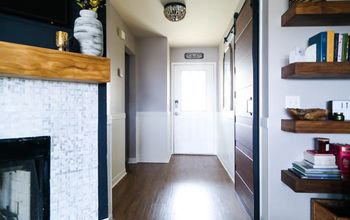
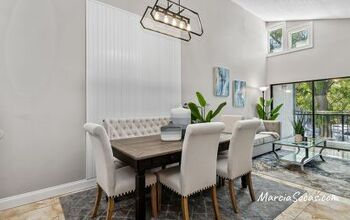
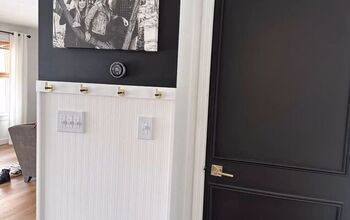

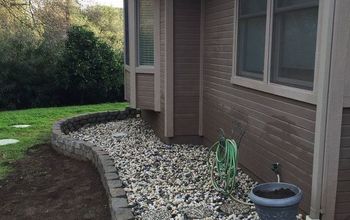

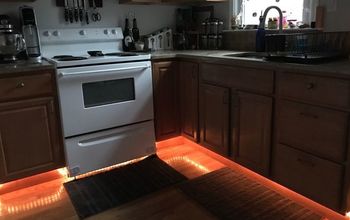
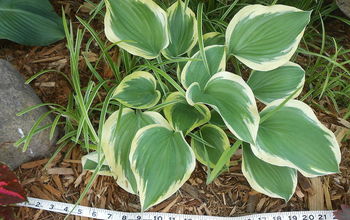

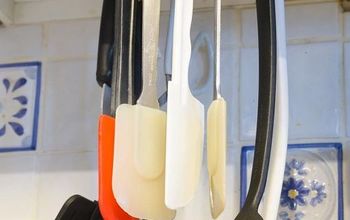
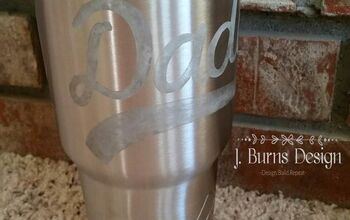

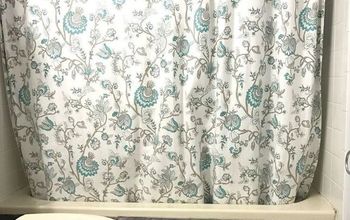



Frequently asked questions
Have a question about this project?
We did ours to 4 ft. Turned out beautiful!
Where did you get the wallpaper?
How long are the brads? Do they go through the board and the wall and into the stud? How long are the brads going through the 1 x 6? How long are the brads going through the baseboard?